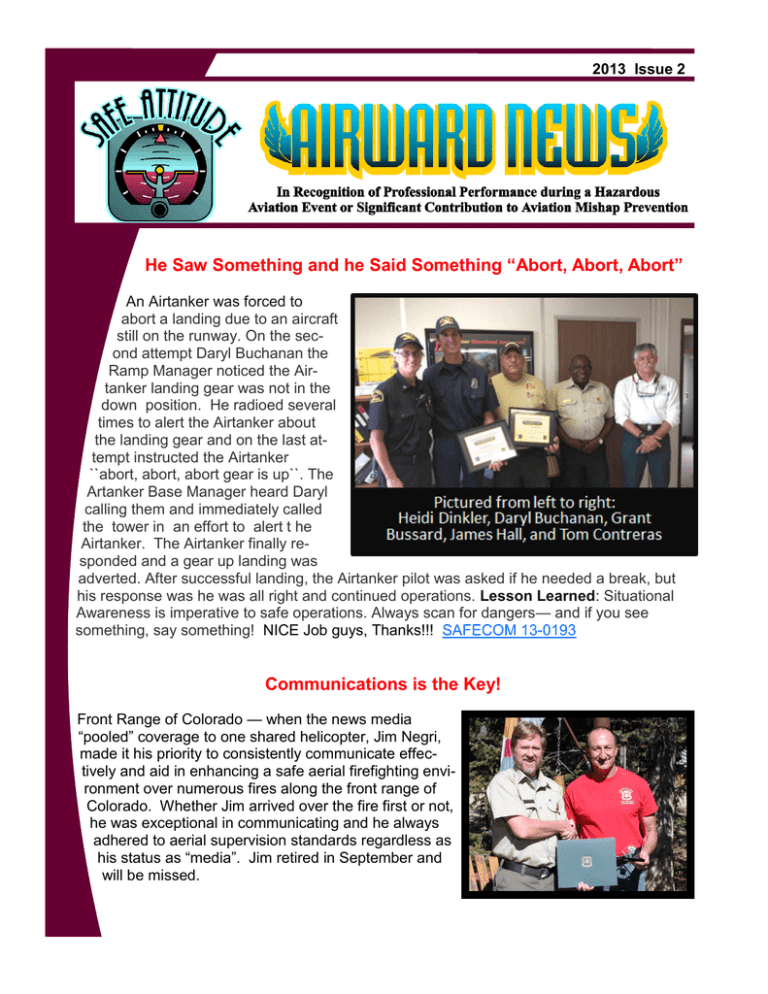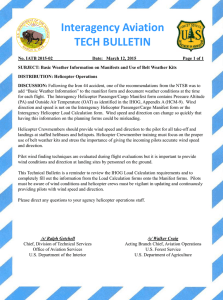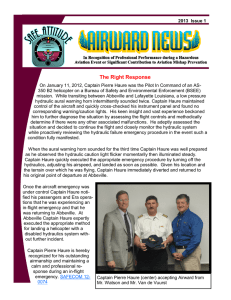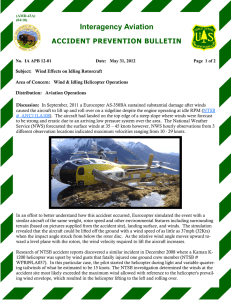He Saw Something and he Said Something “Abort, Abort, Abort”
advertisement

2013 Issue 2 He Saw Something and he Said Something “Abort, Abort, Abort” An Airtanker was forced to abort a landing due to an aircraft still on the runway. On the second attempt Daryl Buchanan the Ramp Manager noticed the Airtanker landing gear was not in the down position. He radioed several times to alert the Airtanker about the landing gear and on the last attempt instructed the Airtanker ``abort, abort, abort gear is up``. The Artanker Base Manager heard Daryl calling them and immediately called the tower in an effort to alert t he Airtanker. The Airtanker finally responded and a gear up landing was adverted. After successful landing, the Airtanker pilot was asked if he needed a break, but his response was he was all right and continued operations. Lesson Learned: Situational Awareness is imperative to safe operations. Always scan for dangers— and if you see something, say something! NICE Job guys, Thanks!!! SAFECOM 13-0193 Communications is the Key! Front Range of Colorado — when the news media “pooled” coverage to one shared helicopter, Jim Negri, made it his priority to consistently communicate effectively and aid in enhancing a safe aerial firefighting environment over numerous fires along the front range of Colorado. Whether Jim arrived over the fire first or not, he was exceptional in communicating and he always adhered to aerial supervision standards regardless as his status as “media”. Jim retired in September and will be missed. Risk Management and Professional Flying During High Tempo Firefighting Operations On August 8th 2013 during the second operational period on the McCann Fire at 5:45 PM, air attack spotted 4 cowboys pushing a herd of cattle at the head of the fire. The fire was below them and pushing towards their direction. Fire Managers made the decision to send all resources to assist in the incident. Air Attack requested a Type I Helicopter, which had just timed out at helibase, in addition to anything else available. A Type II Helicopter was already conducting bucket work and approaching 8 hours of flight time for the day. The Type 1 Helicopter had just left the helibase and promptly returned. The Helibase Manager made the decision that due to the possible loss of life to deviate from the 8 hours of pilot flight time policy. The Helibase Manager then called the Unit Aviation Manager and Incident Commander, informing them of the situation. The Type III arrived at the head of the fire and due to his bucket being belly hooked and smaller, he was able to go under the column and find the cowboys and head of the fire. An Aerial Supervision Module directed the helicopters and a Leadplane, led a Single Engine Air Tanker (SEAT) into the drop zone near the cowboys. The SEAT retardant dropped along with the helicopter bucket drops checked the flame front long enough so that the cowboys and cattle could get into the black. As a result of the mission, the Type I Helicopter flew 8.5 hours and the Type II Helicopter flew 8.4 hours for the day. Air attack commended both the SEAT and helicopter pilots for possibly saving the lives of 4 cowboys on horseback and a large herd of cattle. The helicopter pilot’s swift response in the time of an emergency was much appreciated by all parties. A job well done by all during the risk management process which included helicopter managers, helibase manager, pilots and air attack for coordinating flawless execution during a high tempo firefighting operation. SAFECOM 13-0662 Jim Ranney (left), Ryan Brooks (center), and Garrett Strokes (right). Tom Fox not pictured. 2 Flying High For Safety Gary Daniel has demonstrated a passion for aviation safety by targeting his efforts at improving the skill set of Air Tactical Group Supervisors and reducing the risk of near mid-air collisions. Gary has spent multiple hours helping to develop and implement National ASM Training. His efforts to promote aviation safety include but are not limited to completing the administrative aspects of hosting a National course; ensuring a skilled cadre is available for the aviation, dispatch and ground resources; establishing an adequate location with facilities and airspace to support the training; developing scenarios for all participants and providing liaison with military and local entities. His Gary Daniel (right) receiving involvement and effort has gone beyond Airward from Jami Anzalone typical instructor expectations for one course. Gary is a true leader in aviation safety by walking the walk of SMS and operating with safety as a core value. Great Risk Decision by Helicopter Pilot Shortly after delivering a load of drinking water on the Tres Lagunas Fire, Trans Aero pilot Jeff Hueser experienced a microburst downdraft that affected the flight of his helicopter. He reacted quickly and decisively by immediately jettisoning the longline beneath the aircraft. Not wanting to “push it” Jeff set the ship down at the nearest viable location which happened to be at the mobile retardant plant to wait out the weather. Once the storm had passed, he continued on to the helibase. Jeff made great risk decisions to operate at the lowest risk possible when faced with an unexJeff Hueser (right) receiving Airward from pected situation. He demonstrates the Jami Anzalone (left) and Joe Scholz (center) commitment to safety we encourage all our aviation personnel to exhibit. Thanks, Jeff for leading by example when it comes to aviation safety. SAFECOM 13-0247 3 He Went The Extra Mile When Bode Aviation was awarded a contract for air tactical platform services, they knew they would have to make adjustments to ensuring the aircraft remained within contract compliance. The company would periodically send a mechanic to check the aircraft at their own expense outside of regularly scheduled maintenance. Steve Johnson, Director of Maintenance, was conducting one such visit when he noticed a trim control that seemed off. Although the aircraft was still 100 hours from the next scheduled maintenance and he could have waited, Steve made the risk decision to ground the aircraft and verify what was going on. Steve found the control cable had frayed 8 inches in length and was on its way to becoming inoperable. Steve’s proactive maintenance reviews, attention to detail and concern for safety over profit demonstrate a strong safety culture. Steve Johnson went the extra mile in promoting SMS values and for that we Steve Johnson (left) recognize him and his effort to preventing the next and Jami Anzalone accident. Great job, Steve. SAFECOM 13-654 Outstanding Airmanship and Judgment On September 13, 2013, Captain Alan Bell was the Pilot in Command of an American Eurocopter AS 350 helicopter on a Bureau of Safety and Environmental Enforcement (BSEE) mission. While enroute from the Louis Armstrong International Airport in New Orleans to an offshore platform with two BSEE inspectors on board Captain Alan Bell observed a subtle discrepancy in the aircraft’s torque meter and made the right decision to turn around and land to have the gauge checked by maintenance rather than continuing the mission and hoping for the best. The torque meter, which shows the pilot how much power the engine is delivering, is a small instrument located at the top of the instrument panel. Pilot’s commonly monitor the torque meter when they are changing their power settings during take-off, landing, or maneuvering. In this instance, Captain Bell was in cruise flight when he observed the torque meter indicating 60% when he knew it should be indicating 80% or more. Taking a conservative approach, Captain Bell notified the BSEE inspectors of the situation and turned the helicopter around to land at New Orleans where maintenance personnel could properly evaluate the gauge. After landing at New Orleans the torque meter failed completely. It’s a credit to Captain Bell’s alertness, and professional approach to cross-checking all of his instruments, that he was able to detect a small change in an instrument that isn’t connected to any caution or warning light, and which is often overlooked during cruise flight. Captain Alan Bell is hereby recogCaptain Alan Bell (right) receiving nized for his vigilance, professional airmanship and conservative response to a subtle change that could award from Brian Salerno (left) have had major consequences. SAFECOM 13-0919 4 Speak Up; It’s The Right Thing To Do When Brian Kliesen sees an issue, he is willing to not only speak up, but also go the extra mile to find the lowest risk way to operate. Brian has spoken up several times recently. First, he saw a concern with helicopter cargo equipment and researched the issue through contracting. He also identified inconsistency with helicopter bracing positions being taught compared to an older Safety Alert still active in the system. Finally, this season Brian experienced helicopter passengers sticking untethered objects out the helicopter window while in flight, even after they had specifically been briefed not to. Brian’s commitment to aviation safety is such that he Brain Kliesen (left) and not only reported these events through the Jami Anzalone (right) SAFECOM system, but also worked with Regional and Washington Office staff in developing National Safety Alerts to help spread the information. Brian is leading by example in promoting safety as a core value. He is walking the walk and talking the talk. We appreciate Brian Kliesen for all his efforts at keeping our aviation safety culture strong. SAFECOM 13-0684 Following Up On Maintenance Repairs A blade attachment bolt bottom plug/cap on a Bell 206L Long Ranger was found to be loose while the aircraft was sitting at a helispot, and when physically examined it separated from the lower portion of the bolt. The bolt is hollow and houses weights used in balancing the rotor system. A field repair was performed and the aircraft continued flight operations. When Fred Mascher heard about it he decided to follow-up to ensure the correct procedures for returning it to availability were completed. He quickly discovered that no contact was made with the Aircraft Maintenance Inspector (AMI) or the Contracting Officer Representative (COR) to return the aircraft to availability. He then worked with Regional Office, which in turn issued a Regional Safety Alert which emphasized that “The agency AMI must make the decision if the aircraft is available for use, not the pilot or aviation user.” Thanks Fred for checking it out and not just assuming that all procedures had been Pictured from left to right: Kristin Bail, followed. SAFECOM 13-133 Riva Duncan, Fred Mascher and Jack Finley 5 Setting the Standard for Professionalism “Flock of gulls circling ahead of you.” “Helicopter, 2 o’clock, 1 mile, looks like he’ll pass well above us.” “Watch the jet on approach.” “Immediately after this bend in the canyon there are multiple powerlines.” So goes the typical banter of an experienced aircrew flying low level surveys. What is different in this case is that Ted Nichols of the New Jersey Division of Fish and Wildlife and Paul Castelli of the US Fish and Wildlife Service have been providing this real-time safety information to pilots for a combined total of over half a century. Castelli has served as an observer and air crew member for the Mid-winter Waterfowl Surveys in New Jersey since 1982, completing his 31 st consecutive survey this year. Nichols began a decade later, with 2013 marking his 21st consecutive survey. Nichols and Castelli set the standard for professionalism in wildlife surveys; not only are they experts in waterfowl identification, they consistently, calmly and accurately point out in -flight hazards, and recognize when sterile cockpit rules apply. They play a large role in safely surveying one of the most complex and busy regions of the country, which includes the hyper-sensitive, restrictive, multiple-class airspace of New York City and the Philadelphia Class B. Their experience and knowledge of the topography, airspace, hazards and survey methodology has resulted in their serving as de facto trainers to the many biologist/pilots who have flown with them over the decades. And even when the wheels are chocked, these biologists stay to lend a hand fueling and preparing the aircraft for the next day of surveys. In short, Castelli and Nichols enhance safety every day through their attitudes and assertive action. For that reason, the Department of the Interior and the US Fish and Wildlife Service are proud to recognize two safety stalwarts! Paul Castelli (left) and Ted Nichols (right) Attention to Detail Prevented Potential Mishap On July 8, 2013 while working as a Helicopter Manager, Connie Stickel crawled under the belly of a Bell 212 helicopter to unhook the longline. She noticed that there seemed to be more oil than usual on the belly and around the hook. She also found a small amount of drip. There was no chip light indication but Connie alerted the pilot and mechanic. The mechanic began checking the aircraft and found a crack in the transmission. The aircraft was grounded and the transmission completed. Connie is an experienced Helicopter Manger who has always paid attention to details. Her communication and interaction with flight crews as well as her safety conscious attitude leads to confidence in her actions. In this case, her actions may have very well prevented disastrous results. SAFECOM 13-0472 6 Outstanding Airmanship and Judgment On September 9, 2013, Captain Roland Landry was the Pilot in Command of an Agusta A109E helicopter on a Bureau of Safety and Environmental Enforcement (BSEE) mission. While enroute to the Era Helicopter facility at Houma, Louisiana with two BSEE inspectors on board Captain Landry observed the caution light for the number 2 engine oil temperature illuminate. After quickly cross-checking the engine oil temperature gauge and confirming that the temperature was above the maximum limit Captain Landry immediately reduced power and prepared to shut down the number 2 engine. While Captain Landry reviewed the aircraft’s emergency checklist he monitored the engine oil temperature noting that it was not decreasing despite the reduced power setting. Then, in compliance with the aircraft’s emergency checklist, Captain Landry shut down the number 2 engine. Once he had shut down the number 2 engine Captain Landry notified Era Operations in Lake Charles of the emergency and of his intentions to continue to Houma and land. Captain Landry realized that with one engine inoperative he wouldn’t be able to land to the Era parking area as usual so he called ahead to the Houma Control Tower to notify them of his emergency and requested to land on runway 36. While approaching the airport and preparing to make a single engine landing Captain Landry had the presence of mind to contact Era Operations at Houma inform them of the emergency and to request a vehicle be dispatched to pick up the BSEE Inspectors. During this very busy time Captain Landry also kept the BSEE Inspectors informed of the situation and what to expect during the landing. At Houma, he expertly executed the emergency procedure for landing an Agusta Captain Roland Landry (left) receiving 109E with one engine inoperative without further award from Brian Salerno (center) incident. Captain Landry is hereby recognized for and Brian Domangue (right) his outstanding airmanship and maintaining a calm and professional response during an in-flight emergency. SAFECOM 13-0918 Aviation Safety Offices http://www.fs.fed.us/fire/av_safety/ http://oas.doi.gov/safety/ 7





